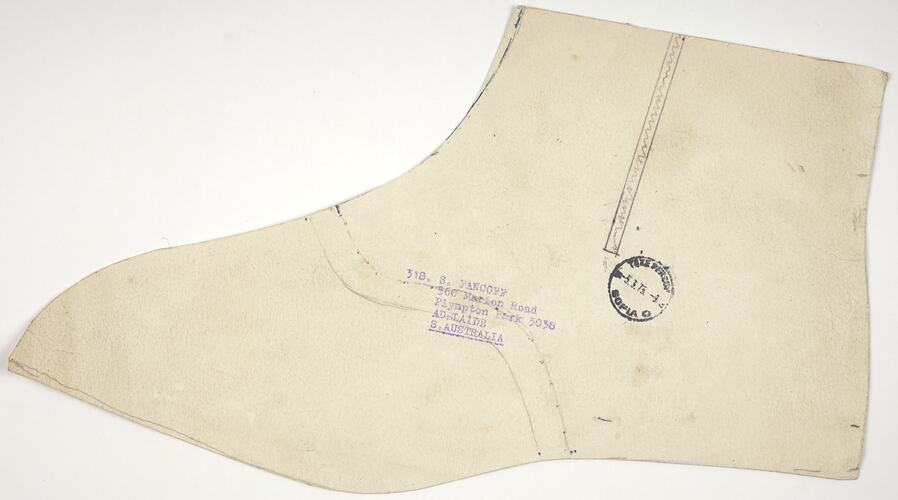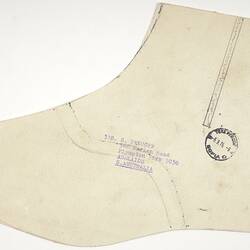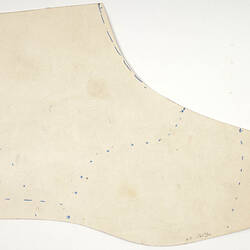Summary
This hand-cut ankle boot pattern has been created on thick quality cream paper most likely used by Stanio Fancoff for creating his various shoes. Stamped with S.Fancoff and his Adelaide address locates this pattern to have been created in the 1950s, during the later years of Stanio Fancoff's shoemaking career. Amongst many others, this pattern is part of the shoemaking designer kit that enabled Stanio to acquire versatility and different fashions within his shoemaking trade.
Stanio Ivanoff Fancoff was born in 1908 in Bojentsi, a small village in Bulgaria. At age 11, Stanio left home to learn the shoemaking trade. In 1929, he immigrated to Melbourne, settled in Fitzroy and began to work for the V.G. Zemancheff & Sons basket shoe factory in South Melbourne. In1936, he married Dorotea Georgi Touzou who had recently arrived in Australia. Around this time, Stanio set up his own shoemaking business from home, with Georgi, her cousin and sister weaving the shoes which he then assembled. Select shoe samples were then taken to Sydney and Tasmania for sale. In 1942, Georgi and Stanio moved to Broken Hill for Georgi's health; there daughter Nancy was born and Stanio set up a shoe shop/factory. In 1945, Georgi died and by 1950 Stanio and Nancy had moved to Adelaide where he again opened a shoemaking business and shop. He passed away in 1978, having been in the shoemaking business for 59 years. This collection documents his migration and working life experiences.
Physical Description
The boot pattern is created on high-quality cream coloured paper. Drawn within a side-perspective with its toe facing left, the pattern's shape infers it to be a men's ankle boot. Centrally located within the top edge's ridge are two vertical parallel lines with a central zig-zag scribble that descends approxmately 9.5 cm down the boot where a horizontal line encloses the shape (references ZIP). Midway along the tongue area, two pencilled parallel lines whereby the top with evenly spaced dots create an elongated snake down to the boots shank. At the toe's sole a penciled line approximately .5cm in from the shoe's base and ending approximately at the forefoots back creates a triangle. Furthermore, the top tongue area exhibits pen marks that form a sporadic line to the tongues midway point. In addition the boot has two stamps, the first is located just below and to the right of the zipper base. Stamped within black ink, this circular shaped stamp measuring approximately 2.5 cm diameter references Sofia Co. The second stamp is forged in purple ink and centrally located within the boot's shape it reference S. Fancoff and his address.
Significance
This collection is significant in documenting a small migrant business as well as the fashion of a particular period. It is well provenanced and charts the application of trade skills in a new country. It also illustrates the stages of hand shoe manufacture from the 1930s, demonstrating the enduring nature of the tools and patterns that were used.
More Information
-
Collecting Areas
-
Acquisition Information
Donation from Nancy Vasileff, 21 Mar 2007
-
Maker
-
Inscriptions
Stamped in Purple Ink, central position :318. S. FANCOFF/560 Marion Road/Plympton Park 5038/ADELAIDE/S. AUSTRALIA.(country is underlined) Stamped in Black Ink, posited around ankle bone location, circle format: taxe perzuf / 5.3. 75. -9. SOFIA Co
-
Classification
-
Category
-
Discipline
-
Type of item
-
Overall Dimensions
328 mm (Width), 190 mm (Height)
-
References
R.A. Salaman, 'Dictionary of Leather-working Tools c.1700-1950 and Tools of Allied Trades,' London: George Allen and Unwin (Publishers) Ltd, 1986 [Section 2: Boot and Shoe Maker pp18-185]. John Peacock. 'Shoes, The Complete Sourcebook,' London:Thames & Hudson Ltd, 2005. NAA holds file (online) on Vasil George Zemancheff, Fancoff's employer
-
Keywords
Boot & Shoemaking, Bulgarian Communities, Bulgarian Immigration, Immigration, Small Businesses





